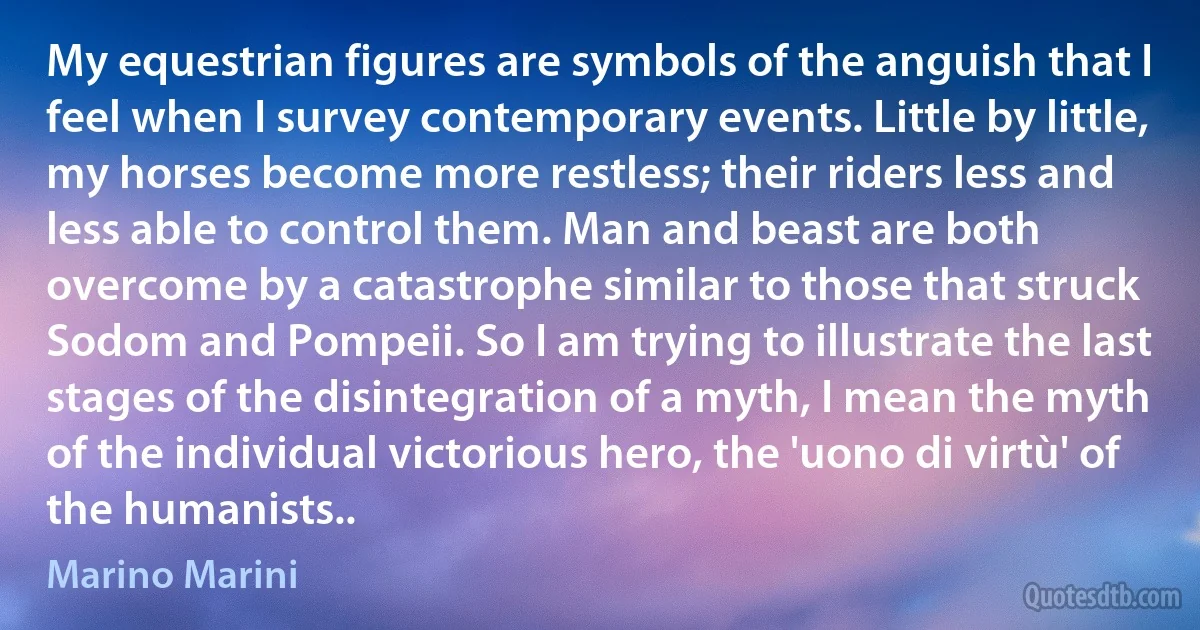Marino Marini quotes
My equestrian statues express the torment caused by the events of this century. the restlessness of my horse increases with each new work, the rider is always more exhausted, he has lost his domination of the beast and the catastrophes to which he succumbs resemble those that destroyed sodom and pompeii. I aspire to make visible the last stage of destruction of a myth, of the myth of heroic and victorious individualism, the humanists' man of virtue. my work in the last years doesn't want to be heroic, but tragic.

Marino Marini
But I am no longer trying to formulate a stylised version of anxiety such as we find in the Laocoon group and in so many other sculptures of the Silver Age of antiquity. I feel that these works are always a bit too melodramatic. If you really want to find the sources of my present style [1958] in antiquity, I must confess that you will find them in the remains of the life of the past rather than in those of its art. The fossilized corpses that have been unearthed in Pompeii.... if the whole earth is destroyed in our atomic age, I feel that the human forms which may survive as mere fossils will have become sculptures similar to mine.

Marino Marini
Equestrian statues have always served, through the centuries, a kind of epic purpose. They set out to exalt a triumphant hero, a conqueror like Marcus Aurelius... In the past fifty years, this ancient relation between man and beast has been entirely transformed. The horse has been replaced, in its economic and its military functions, by the machine, by the tractor, the automobile or the tank.

Marino Marini
Until the end of the fascist era and of the war [World War 2. ], I continued to hark back to the sober realism [in his human figure sculptures, then] of the artists of the Etruscan funerary figures, or the sculptors of some Roman portraits, especially the earlier ones. My own way of reacting against the imperialist pathos of official Fascist art continued, until 1944, to consist in identifying my art very consciously with my private life, so that I never allowed myself any form of expression that might seem too blatantly public.

Marino Marini
There is an intimate relationship between my pictorial [2-dimensional] and my sculptural work. I would never begin on a sculpture without first gaining an idea of the colour... My mind is captivated by this task until I start to put down the colour on paper and imagine that this colour will become a drawing. And then, suddenly, the drawing begins to acquire shape, the shape, and this shape becomes the real shape.

Marino Marini
I had been born in an Earthly Paradise [in Tuscany, Italy] from which we all have expelled. Not so long ago a sculptor could still be content with a search for full, sensual and vigorous forms. But in the past fifteen years [1943 – 1958], nearly all our new sculpture has tended to create forms that are disintegrating.

Marino Marini
We must enter into the spirit of the character [for making a portrait]: here the challenge is to place this figure in the human space, to work out what he represents in relation to other people, other human personalities; when you've worked this out, you're done. this truth has to stand out in the end result of the portrait.... when this task is complete, and the subject is placed in the realm of the dead that go on living, I hand over my work.

Marino Marini
Machines change their style so rapidly. If one tries to reproduce them in art as realistically as man and the horse in classical art, one immediately lapses into a kind of anecdotic or documentary art... Only the stylisation of a painter like Leger could integrate the machine as the subject matter of art. Here in Italy, the futurists, before 1914, attempted a similar integration of the machine.... César [French sculptor, in the generation of Marini] creates with elements borrowed from industry and the world of machines, sculptural fossils that appear to have survived the same kind of catastrophe as my own figures. But I would like to show you [ interviewer w:Eduard Roditi now in my studio my latest fossils..

Marino Marini
The Romantic painters were already addicted to a cult of the horse as an aristocratic beast.... From Géricault and Constantin Guys [both Romantic French painters] to Degas and Dufy, this cult of the horse found its expression in a new attitude towards sport and military life... In Odilon Redon's visionary renderings of horses and later in those of Picasso and Chirico, we then see the horse become part of the fauna of a world of dreams and myths.

Marino Marini
![I am no longer seeking, in my own equestrian figures, to celebrate the triumph of any victorious hero. On the contrary, I seek to commemorate in them something tragic – in fact, a kind of 'Twilight of Man', a defeat rather than a victory. If you look back on all my equestrian figures of the past twelve years [between 1946 – 1958] you will notice that the rider is each time less in control of his mount, and that the latter is each time more wild in its terror, but frozen stiff, rather than reared or running away. All this is because I feel that we are on the eve of the end of a whole world. (Marino Marini)](https://cdn.quotesdtb.com/img/quotes_images_webp/27/marino-marini-contrary-control-852427.webp)

